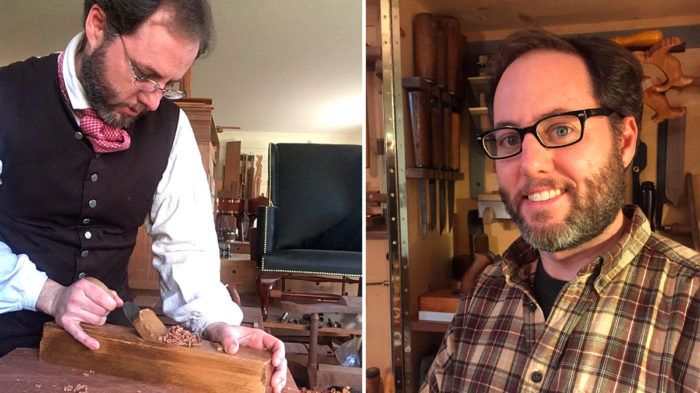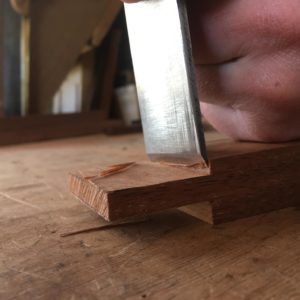The Double Life of Bill Pavlak
By day, Bill Pavlak works in the Anthony Hay Cabinet Shop at Colonial Williamsburg, but by night... well... he's a regular old boring woodworker
For 40 hours a week, I work in the Anthony Hay Cabinet Shop at Colonial Williamsburg and yes, my shoes have buckles and my sleeves an impressive poofiness. I also build furniture at home in a 21st century way, though still mostly with hand tools and traditional joinery. The contrasts between the two approaches often seem stark, but how different are they really?
First, the obvious differences: For at least a quarter of my time at Colonial Williamsburg, I interpret my craft to the visiting public. The shop is idyllic in many ways, but it’s not a quiet, therapeutic retreat from the world. It’s open to the world and that’s a good thing. I primarily rely on natural light in the Hay shop, which is beautiful to work by when it’s there, but rainy or overcast days and the month of December are not so productive. Candlelit dinners are romantic, a candlelit cabinet shop, not so much.
What about the tools? Most lists of essential hand tools include a combination square, a low-angle block plane, and a shoulder plane. These are certainly go-to tools in my home shop, but they just weren’t used by 18th-century cabinetmakers. In Williamsburg I’m as much a historian as I am a craftsman and it’s the process as well as the product I’m seeking to recreate. So what’s the result of their absence? Honestly, the chief issue seems to be that they offer a higher degree of convenience.

This is most true with a combination square, where the name says it all. Instead of one tool for several jobs, in the Hay Shop I use a different tool for each task. The only true challenge is to learn how to not cut into your wooden square while knifing in layout lines.
The block plane’s versatility is sorely missed while I’m at work. I do most of its tasks with my smooth planes or a strike block plane (a low-angle plane close in size to a smoother), but they are not as well suited for delicate jobs like leveling off dovetail joints or finessing small parts. I think this is due to size.

With a block plane, my hand is close to the blade and closer to the work, which gives a heightened sensitivity. Other tools keep my hands farther away. Sure there were many smaller planes available to 18th-century workers, but they are more likely to be found in the inventories of luthiers rather than cabinetmakers.
Of these three tools, the absence of shoulder planes presents the biggest shift in approach as we head back through time. Instead of relying on a sharp blade and a flat sole to shoot the end grain of a tenon shoulder, I need a sharp, wide chisel, a steady hand, and careful overlapping cuts. Fine-tuning tenons is rarely easy, and chiseling shoulders straight adds a further degree of difficulty, but that kind of freehand chisel control is worth acquiring for any number of tasks.

As far as shop fixtures like benches, vises, and clamps are concerned, the differences between my two woodworking lives are fairly subtle. At home I’m much more likely to make jigs and fixtures because materials like plywood and MDF make that process fairly quick. At work everything starts as roughsawn lumber that needs to be processed by hand, so I’m unlikely to make a jig unless I know it can be used for a lot of work over a long time.
Ultimately, the biggest difference between my pre-industrial approach and my contemporary one may be choice. At home I can choose hot hide glue or PVA, treadle a lathe or flip a switch, process everything by hand or use machines and hand tools in harmony. In the Hay Shop we pore over period surfaces for tool marks and sift through documents and museum collections for insight into how we may best limit ourselves to the tools and design language of a time long past. As I’ve become more comfortable in our imagined version of 18th-century Virginia, the technical limitations of the past seem far less limiting. All the seemingly subtle differences among different generations of hand tools begin to add up to something profound: a deeper, though still wildly incomplete, understanding of the past.
In my mind 18th-century tools are not required to make good period reproductions, but an awareness of how those tools impact the overall aesthetic is crucial. I’ve also come to realize something I’ve told countless visitors in recent years: There has never been a better time to be an 18th-century cabinetmaker than the 21st century. The work is far more enjoyable now than it could have possibly been then. In fact, looking around at the furniture and tools now being made, I could say the same for furniture making in general.

Fine Woodworking Recommended Products

Bahco 6-Inch Card Scraper

Starrett 12-in. combination square

Stanley Powerlock 16-ft. tape measure



























Comments
I can appreciate your challenge in figuring out how things were made 200 years ago. I am trying to figure out how the slots in tape heddles were made for tape looms. I know that today some folks use a chop saw (or something similar) but I don’t know how the slots were made. Did they use a handsaw and make a plunge cut or did they use a chisel? My wife does living history and demonstrates different weaving techniques with the tape loom. It would be nice to be able to go with her and show folks how the tape loom is made.
Donald
I now know what a tape loom is. From all of the pictures I looked at, not all were made using a single piece of wood. I would say that any method, using known tools of yesteryear, would result in an authentic product... As to using just a chisel, I think you would create a lot of kindling. It is refreshing to learn that some "purists" know where the switch is located..Also nice to learn that there is at least one "purist" who isn't a snob about it. Some have to fall their own tree, debark, split and produce their stock with hand tools- maybe to be authentic 1700 era items, they used a horse to pull that log out of the woods. The power tools we have today, all, and I do mean all, came about for two reasons: 1. Eliminate labor intensity, and I forget the second reason.... And they can trace their ancestry..... Thanks Bill for a well written article
I really enjoyed this blog especially since I already have reservations for a week at Colonial Williamsburg at the end of May/first of June. I hope to meet Bill or at least see him work.
I notice Bill wears glasses and it made me wonder about how much affect that would have had on a cabinet maker in the Colonial Period since the optics weren't nearly as good as today? It's stunning to me to see the quality of period furniture knowing the limitations the makers had versus today.
Thanks again for the article!
Hello Bill, enjoyed this article and thought you might like to see a painting my wife did of you after we visited the Williamsburg shop! She's an artist and I too am a woodworker. Contact my through my website http://www.woodworksbyjohn.com and I can send you an image it you'd like. Check out the painting she did of me while you're on the blog -- yours is not quite as detailed!
Log in or create an account to post a comment.
Sign up Log in